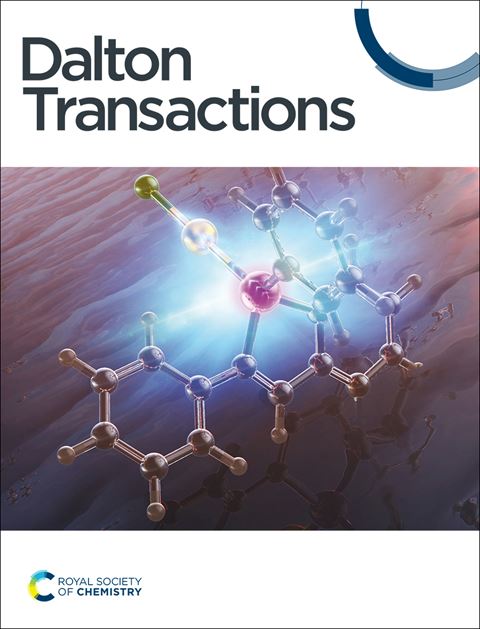利用苯并[d]恶唑配合物在可见光下高效光催化将CO2还原为CO
IF 3.5
3区 化学
Q2 CHEMISTRY, INORGANIC & NUCLEAR
引用次数: 0
摘要
合成了六种具有不对称二亚胺配体5,7-二叔丁基-2-(吡啶-2-基)苯并[d]恶唑、2-(吡啶-2-基)萘并[1,2-d]恶唑、2-(吡啶-2-基)萘并[2,3-d]恶唑、2-(喹啉-2-基)苯并[d]恶唑、2-(喹啉-2-基)萘并[1,2-d]恶唑、2-(喹啉-2-基)萘并[1,d]恶唑的同分异构体铑(I)三羰基配合物,并通过分析技术、光谱和单晶x射线衍射对其进行了综合表征。这些配合物被评估为可见光驱动CO2还原的催化剂,无论是否有外部光敏剂(PS),并且在电化学CO2还原中也表现出催化活性,在两种情况下都有效地起作用。在质子供体三氟乙醇(TFE)存在下,配合物产生甲烷和一氧化碳(CO)。在光化学条件下,以三乙醇胺(TEOA)为质子源,在乙腈中实现了高选择性的CO生成。这项工作强调了金属复合光催化剂通过配体设计进行太阳能到燃料转换的可调性。在所研究的配合物中,以2-(吡啶-2-基)萘[1,2-d]恶唑配体为配体的铼配合物的催化效率最高,5小时后CO2还原为CO的周转率为660。利用核磁共振、紫外-可见光谱和时间依赖密度泛函理论(TD-DFT)计算的机理研究提供了对催化过程的深入了解。这些铼(I)配合物在光催化CO2还原为CO方面表现出了良好的潜力,为人工光合作用和太阳能-燃料转换的高效催化剂的设计和开发提供了有价值的见解。本文章由计算机程序翻译,如有差异,请以英文原文为准。
![Highly efficient photocatalytic reduction of CO2 to CO under visible light using rhenium benzo[d]oxazole complexes](https://img.booksci.cn/booksciimg/2025-4/2025041010233728474623.png)
Highly efficient photocatalytic reduction of CO2 to CO under visible light using rhenium benzo[d]oxazole complexes
A series of six isomeric rhenium(I) tricarbonyl complexes featuring asymmetric diimine ligands 5,7-di-tert-butyl-2-(pyridin-2-yl)benzo[d]oxazole, 2-(pyridin-2-yl)naphtho[1,2-d]oxazole, 2-(pyridin-2-yl)naphtho[2,3-d]oxazole, 2-(quinolin-2-yl)benzo[d]oxazole, 2-(quinolin-2-yl)naphtho[1,2-d]oxazole, and 2-(isoquinolin-1-yl)benzo[d]oxazole, was synthesized and comprehensively characterized through analytical techniques, spectroscopy, and single-crystal X-ray diffraction. These complexes were assessed as catalysts for visible-light-driven CO2 reduction, both with and without an external photosensitizer (PS), and also exhibited catalytic activity in electrochemical CO2 reduction, effectively functioning in both regimes. In the presence of a proton donor, trifluoroethanol (TFE), the complexes produced methane and carbon monoxide (CO) electrochemically. Under photochemical conditions, high selectivity for CO production was achieved in acetonitrile with triethanolamine (TEOA) as the proton source. This work highlights the tunability of metal complex photocatalysts for solar-to-fuel conversion through ligand design. Among the complexes studied, the rhenium complex featuring the 2-(pyridin-2-yl)naphtho[1,2-d]oxazole ligand demonstrated the highest catalytic efficiency, achieving a turnover number of 660 for CO2 reduction to CO after 5 hours. Mechanistic studies employing NMR, UV-vis spectroscopy, and time-dependent density functional theory (TD-DFT) calculations provided insights into the catalytic process. These rhenium(I) complexes demonstrate promising potential for photocatalytic CO2 reduction to CO, offering valuable insights into the design and development of efficient catalysts for artificial photosynthesis and solar-to-fuel conversion.
求助全文
通过发布文献求助,成功后即可免费获取论文全文。
去求助
来源期刊

Dalton Transactions
化学-无机化学与核化学
CiteScore
6.60
自引率
7.50%
发文量
1832
审稿时长
1.5 months
期刊介绍:
Dalton Transactions is a journal for all areas of inorganic chemistry, which encompasses the organometallic, bioinorganic and materials chemistry of the elements, with applications including synthesis, catalysis, energy conversion/storage, electrical devices and medicine. Dalton Transactions welcomes high-quality, original submissions in all of these areas and more, where the advancement of knowledge in inorganic chemistry is significant.
 求助内容:
求助内容: 应助结果提醒方式:
应助结果提醒方式:


